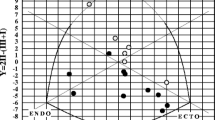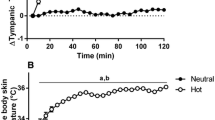Abstract
Tympanic temperature (Tty), skin temperature, and regional dry heat loss were measured continuously in eight female subjects under three conditions: (1) stepwise increases in ambient temperature (Ta) from 26 °C at 09:00 to 30 °C at 18:00, (2) steady Ta at 28 °C from 09:00 to 18:00, and (3) stepwise decreases in Ta from 30 °C at 09:00 to 26 °C at 18:00. Oxygen consumption, body weight loss, thermal sensation, and comfort levels were periodically recorded. The Tty increased significantly (p < 0.01) from 36.1 ± 0.36 °C to 36.6 ± 0.23 °C at 18:00 under condition 1 but remained virtually unchanged under conditions 2 and 3. Thermal comfort was observed at 15:00 and 17:00 under condition 3, whereas subjects reported that they felt slightly cool at 15:00. The rate of body heat storage (S), changes in Tty, mean skin temperature (\( \overline{T} \)sk), and mean body temperature during each period were calculated, and confirmed that changes in \( \overline{T} \)sk was correlated with S. Diurnal changes in core temperature (Tc) appeared to be more dependent on diurnal rhythm than on changes in Ta, except when Ta increased continuously. Thus, it may be difficult to predict diurnal changes in women’s Tc using a body-heat-balance equation during thermal transient.






Similar content being viewed by others
References
Berglund, L. G., 2001. Thermal comfort, in Baird, J. (ed.) 2001 ASHERAE handbook: fundamentals, American Soc. heating, Refrigerating & air-conditioning Eng., Inc., Atlanta, 8.1–8.29
Ciuha U, Mekjavic IB (2016) Regional thermal comfort zone in male and females. Physiol Behav 161:123–129
Ciuha U, Mekjavic IB (2017) Thermal comfort zone of the hands, feet and head in males and females. Physiol Behav 179:427–433
Gerrett N, Ouzzahra Y, Redortier B, Voelcker T, Havenith G (2015) Female thermal sensitivity to hot and cold during rest and exercise. Physiol Behav 152:11–19
Golja P, Tipton MJ, Mekjavic IB (2003) Cutaneous thermal thresholds—the reproducibility of their measurements and the effect of gender. J Therm Biol 28:341–346
Grivel F, Candas V (1991) Ambient temperatures preferred by young European males and females at rest. Ergonomics 34:365–378
Hardy JD, DuBois EF (1938) The technic of measuring radiation and convection. J Nutr 15:461–475
Inoue Y, Ogura K, Asami S, Ueda H, Ishuyubi H, Shirataki M, Kondo T (2000) Gender difference and menstrual cycle on skin blood flow in the heat. Proc Jpn Soc Phys Fit Sports Med 49:899 (Written in Japanese)
Kakitsuba N, Mekjavic IB (2018) Diurnal variation in the core interthreshold zone in women and its sex difference. Int Physiol J:26–37. https://doi.org/10.14302/issn.2578-8590.ipj-18-2078
Kakitsuba N, White MD (2013) Effect of change in ambient temperature on core temperature during the daytime. Int J Biometeorol. https://doi.org/10.1007/s00484-013-0673-8
Karjalainen S (2007) Gender differences in thermal comfort use of thermostats in everyday thermal environments. Build Environ 42:1594–1603
Kurazumi Y, Horikoshi T, Tsuchikawa T, Matsubara M (1994) A study on Japanese body surface area. J Jpn Biometeorol 31:5–29 (Abstract in English)
Liu H, Wu Y, Lei D, Li B (2018) Gender differences in physiological and psychological responses to the thermal environment with varying clothing ensembles. Build Environ 141:45–54
Maykot JK, Rupp RF, Ghisi E (2018) Assessment of gender on requirements for thermal comfort in office buildings in Brazilian humid subtropical climate. Energy Build 158:1170–1183
Morimoto T, Slabochova Z, Naman RK, Sargent F (1967) Sex differences in physiological reactions to thermal stress. J Appl Physiol 22:526–532
Rohles FH Jr, Nevins RG (1971) The nature of thermal comfort for sedentary man. ASHRAE Trans 77:239
Schellena L, Loomansa MGLC, de Wita MH, Olesen BW, van Marken Lichtenbelt WD (2012) The influence of local effects on thermal sensation under non-uniform environmental conditions - gender differences in thermophysiology, thermal comfort and productivity during convective and radiant cooling. Physiol Behav 107:252–261
Schwiening CJ, Mason MJ, Thompson M (2011) Absolute power, not sex, promotes perspiration. Exp Physiol 96(5):556–558
Shanahan TL, Czeisler CA (1984) Light induces equivalent phase of the endogenous circadian rhythms of circulating plasma melatonin and core body temperature in men. J Clin Endocrinol Metab 73:227–235
Stevens GH, Graham TE, Wilson BA (1987) Gender differences in cardiovascular and metabolic responses to cold and exercise, can. J Physiol Pharmacol 65:165–171
Stolwijk JA, Hardy JD (1966) Partitional calorimetric studies of responses of man to thermal transients. J Appl Physiol 21:967–977
Ugursal A, Culp C (2013) Gender differences of thermal comfort perception under transient environmental and metabolic conditions. ASHRAE Trans 119:52–62
Wagner JA, Horvath SM (1985) Influences of age and gender on human thermoregulatory responses to cold exposures. J Appl Physiol 58:180–186
Weir JBV (1949) New methods for calculation metabolic rate with special references to protein metabolism. J Physiol 109(1–2):1–9
Xiong J, Lian Z, Zhou X, You J, Lin Y (2015) Investigation of gender difference in human response to temperature step changes. Physiol Behav 151:426–440
Acknowledgments
This study was supported in part by the Research Center for Future Standards of Living Environments, Meijo University.
Author information
Authors and Affiliations
Corresponding author
Rights and permissions
About this article
Cite this article
Kakitsuba, N. Effect of change in ambient temperature on core temperature of female subjects during the daytime and its sex differences. Int J Biometeorol 63, 1069–1076 (2019). https://doi.org/10.1007/s00484-019-01721-1
Received:
Revised:
Accepted:
Published:
Issue Date:
DOI: https://doi.org/10.1007/s00484-019-01721-1




